The human cathelicidin LL-37 preferentially promotes apoptosis of infected airway epithelium
- PMID: 20097832
- PMCID: PMC2993089
- DOI: 10.1165/rcmb.2009-0250OC
The human cathelicidin LL-37 preferentially promotes apoptosis of infected airway epithelium
Abstract
Cationic host defense peptides are key, evolutionarily conserved components of the innate immune system. The human cathelicidin LL-37 is an important cationic host defense peptide up-regulated in infection and inflammation, specifically in the human lung, and was shown to enhance the pulmonary clearance of the opportunistic pathogen Pseudomonas aeruginosa in vivo by as yet undefined mechanisms. In addition to its direct microbicidal potential, LL-37 can modulate inflammation and immune mechanisms in host defense against infection, including the capacity to modulate cell death pathways. We demonstrate that at physiologically relevant concentrations of LL-37, this peptide preferentially promoted the apoptosis of infected airway epithelium, via enhanced LL-37-induced mitochondrial membrane depolarization and release of cytochrome c, with activation of caspase-9 and caspase-3 and induction of apoptosis, which only occurred in the presence of both peptide and bacteria, but not with either stimulus alone. This synergistic induction of apoptosis in infected cells was caspase-dependent, contrasting with the caspase-independent cell death induced by supraphysiologic levels of peptide alone. We demonstrate that the synergistic induction of apoptosis by LL-37 and Pseudomonas aeruginosa required specific bacteria-epithelial cell interactions with whole, live bacteria, and bacterial invasion of the epithelial cell. We propose that the LL-37-mediated apoptosis of infected, compromised airway epithelial cells may represent a novel inflammomodulatory role for this peptide in innate host defense, promoting the clearance of respiratory pathogens.
Figures
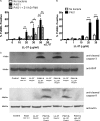
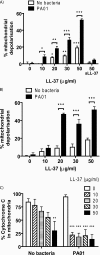
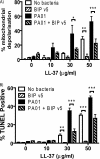
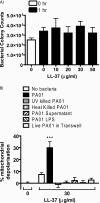
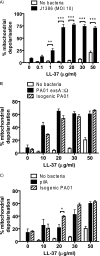
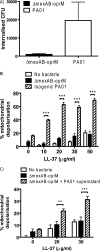
Similar articles
-
Cathelicidin host defence peptide augments clearance of pulmonary Pseudomonas aeruginosa infection by its influence on neutrophil function in vivo.PLoS One. 2014 Jun 2;9(6):e99029. doi: 10.1371/journal.pone.0099029. eCollection 2014. PLoS One. 2014. PMID: 24887410 Free PMC article.
-
Cathelicidin is a "fire alarm", generating protective NLRP3-dependent airway epithelial cell inflammatory responses during infection with Pseudomonas aeruginosa.PLoS Pathog. 2019 Apr 12;15(4):e1007694. doi: 10.1371/journal.ppat.1007694. eCollection 2019 Apr. PLoS Pathog. 2019. PMID: 30978238 Free PMC article.
-
The human host defense peptide LL-37 induces apoptosis in a calpain- and apoptosis-inducing factor-dependent manner involving Bax activity.Mol Cancer Res. 2009 May;7(5):689-702. doi: 10.1158/1541-7786.MCR-08-0274. Epub 2009 May 12. Mol Cancer Res. 2009. PMID: 19435812
-
Human antimicrobial/host defense peptide LL-37 may prevent the spread of a local infection through multiple mechanisms: an update.Inflamm Res. 2025 Feb 11;74(1):36. doi: 10.1007/s00011-025-02005-8. Inflamm Res. 2025. PMID: 40063262 Free PMC article. Review.
-
Tissue-specific Regulation of Innate Immune Responses by Human Cathelicidin LL-37.Curr Pharm Des. 2018;24(10):1079-1091. doi: 10.2174/1381612824666180327113418. Curr Pharm Des. 2018. PMID: 29589544 Review.
Cited by
-
A cross sectional analysis of the role of the antimicrobial peptide cathelicidin in lung function impairment within the ALIVE cohort.PLoS One. 2014 Apr 17;9(4):e95099. doi: 10.1371/journal.pone.0095099. eCollection 2014. PLoS One. 2014. PMID: 24743155 Free PMC article. Clinical Trial.
-
LL-37 modulates human neutrophil responses to influenza A virus.J Leukoc Biol. 2014 Nov;96(5):931-8. doi: 10.1189/jlb.4A1113-604RR. Epub 2014 Jul 31. J Leukoc Biol. 2014. PMID: 25082153 Free PMC article.
-
Cathelicidin host defence peptide augments clearance of pulmonary Pseudomonas aeruginosa infection by its influence on neutrophil function in vivo.PLoS One. 2014 Jun 2;9(6):e99029. doi: 10.1371/journal.pone.0099029. eCollection 2014. PLoS One. 2014. PMID: 24887410 Free PMC article.
-
Synthetic host defense peptide IDR-1002 reduces inflammation in Pseudomonas aeruginosa lung infection.PLoS One. 2017 Nov 6;12(11):e0187565. doi: 10.1371/journal.pone.0187565. eCollection 2017. PLoS One. 2017. PMID: 29107983 Free PMC article.
-
Cathelicidin is a "fire alarm", generating protective NLRP3-dependent airway epithelial cell inflammatory responses during infection with Pseudomonas aeruginosa.PLoS Pathog. 2019 Apr 12;15(4):e1007694. doi: 10.1371/journal.ppat.1007694. eCollection 2019 Apr. PLoS Pathog. 2019. PMID: 30978238 Free PMC article.
References
-
- Zanetti M. Cathelicidins, multifunctional peptides of the innate immunity. J Leukoc Biol 2004;75:39–48. - PubMed
-
- Putsep K, Carlsson G, Boman HG, Andersson M. Deficiency of antibacterial peptides in patients with morbus Kostmann: an observation study. Lancet 2002;360:1144–1149. - PubMed
-
- Nizet V, Ohtake T, Lauth X, Trowbridge J, Rudisill J, Dorschner RA, Pestonjamasp V, Piraino J, Huttner K, Gallo RL. Innate antimicrobial peptide protects the skin from invasive bacterial infection. Nature 2001;414:454–457. - PubMed
Publication types
MeSH terms
Substances
Grants and funding
LinkOut - more resources
Full Text Sources
Other Literature Sources
Medical
Research Materials

